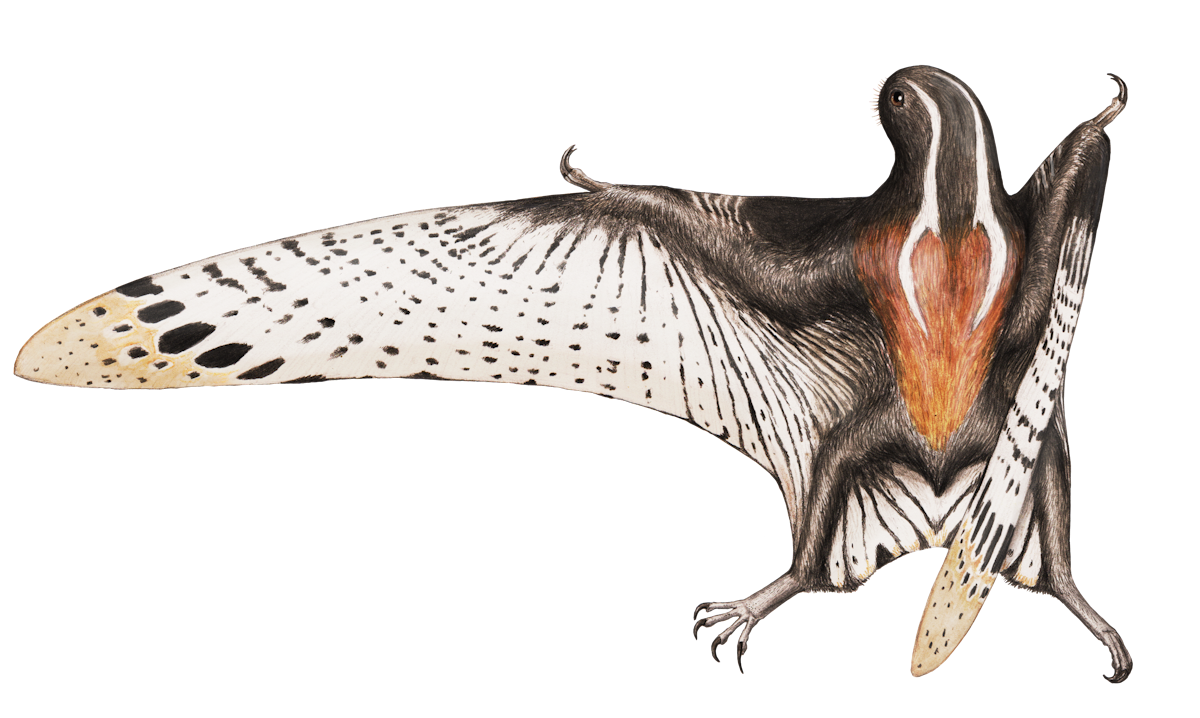Vesperopterylus
Family

Anurognathidae


Family

Anurognathidae

The Lower Cretaceous Jiufotang Formation in northeastern China was home to the anurognathid Vesperopterylus lamadongensis, named by Junchang Lü and colleagues in 2017. It’s based on an almost entirely complete specimen that is largely still in articulation. The name Vesperopterylus is derived from the Latin word “vesper” meaning dusk, and the Ancient Greek word “pteron” meaning wing. The publication initially incorrectly spelled “vesper” as “versper” in the generic name and etymology, although the spelling was corrected in a subsequent version of the paper. The species name refers to the Lamadong locality, where it was originally discovered.
The only known specimen of Vesperopterylus consists of an almost complete specimen lying on its left side missing some neck vertebrae, and the right humerus. The skull is preserved in ventral view and shows its shape and proportions well, but is crushed and difficult to interpret, except for its lower jaw. The skull is remarkably short and broad, being wider than long, and small compared to the rest of the body. The mandible is C- or U-shaped when seen from below, similar to the shape of a frog’s jaw. The teeth of Vesperopterylus are small, slightly curved cones and appear to be restricted to the central part of the jaw.
The neck and torso are relatively long, but the tail is extraordinarily short, being less than half the length of the humerus. Both wings are almost completely known, only missing the right humerus. The arm bones are robust and the hands short, but the wing finger is relatively long. Although the skeleton is largely articulated, both wings and one leg appear to have drifted away from the rest of the body. The right wing drifted away from the body, ending up beyond the right foot. The left wing also drifted away, ending up twisted around the head and neck. The right leg remained in articulation with the hips, but the left leg drifted away from the hips and ended up under the left wing. Because of the completeness of the specimen, its wingspan can be determined to be just under one meter (39 inches).
Lü and colleagues note a unique feature of the feet: an opposable first toe that could help grasp onto branches. The feet of anurognathids and other non-pterodactyloids all have five toes, with digits I-IV being largely similar in anatomy, and with digit V being mostly separated from the foot, and incorporated in the uropatagium. Both feet of Vesperopterylus appear to show the first toe, homologous to our big toe, being offset from the others with its claw pointed in the opposite direction..
Lü and colleagues assigned Vesperopterylus to the anurognathids, a family of small insectivorous pterosaurs known from rocks of the Middle Jurassic to the Lower Cretaceous. Their phylogenetic analysis found that Vesperopterylus was the most basal anurognathid despite being the latest known species. They also found that anurognathids were the most primitive pterosaurs, although that is not a universal opinion. Other analyses have found them to be elsewhere on the family tree, either among the long-tailed pterosaurs or closely related to the short-tailed pterodactyloids.
Vesperopterylus is the last known anurognathid, living 120 million years ago, and is one of only two or three known Cretaceous anurognathid specimens. One of these is an unnamed specimen from the Yixian equivalent Sinuiju Series of North Korea. The other possible specimen is Dendrorhynchoides curvidentatus, originally described as coming from the Yixian Formation, but subsequently thought to come from the Middle Jurassic Tiaojishan Formation.


